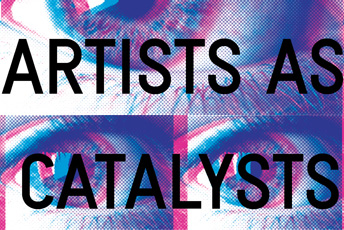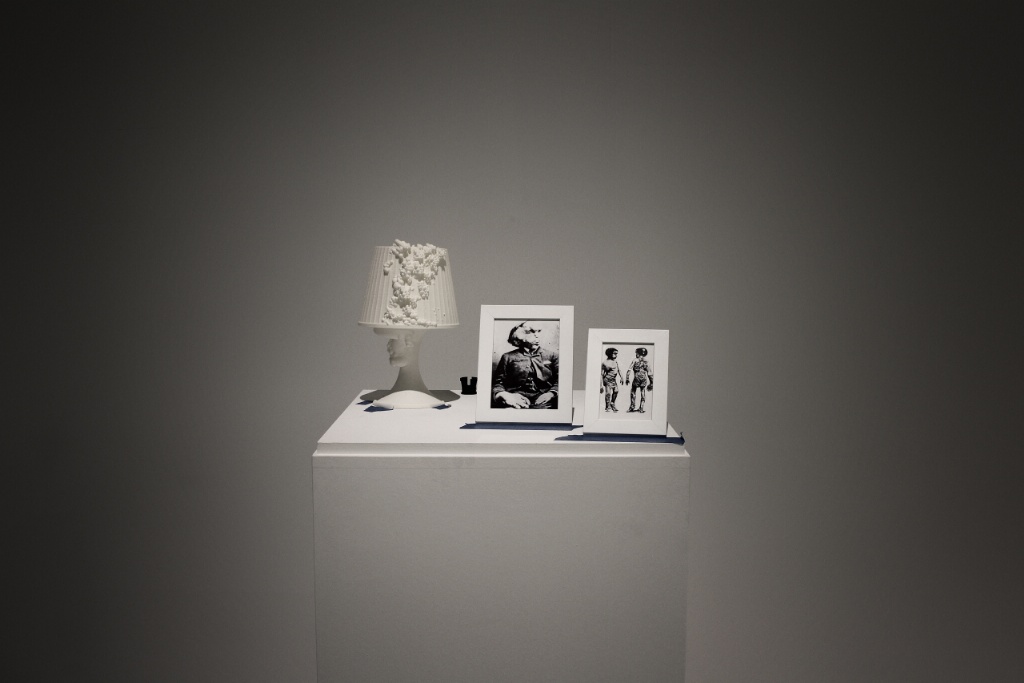Starting on July 4th 2013, “Artists as Catalysts” is the new exhibition curated by Ars Electroncia Linz GmbH. Manuela Naveau, instrumental in curating this project at the Alhondiga in Bilbao/Spain, talks about the topic and the works of the exhibition.
The Alhondiga used to be a vinery and has been rebuilt into a multi-purpose-building by Philippe Starck in 2010. It contains spaces for exhibitions, cinemas, a fitnesscenter and even a swimmingpoo
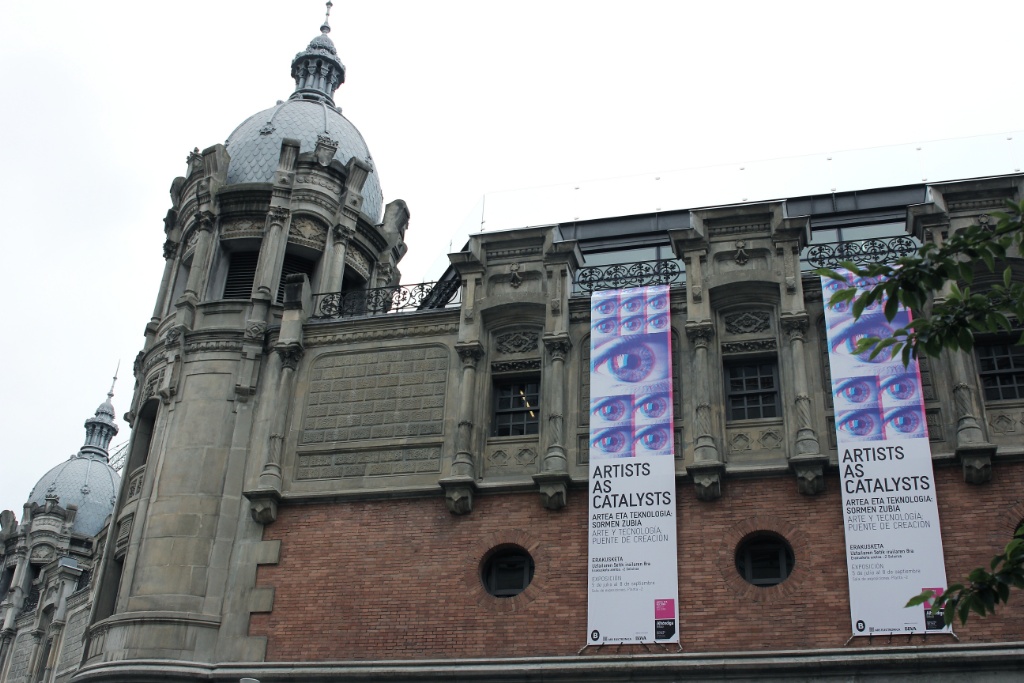
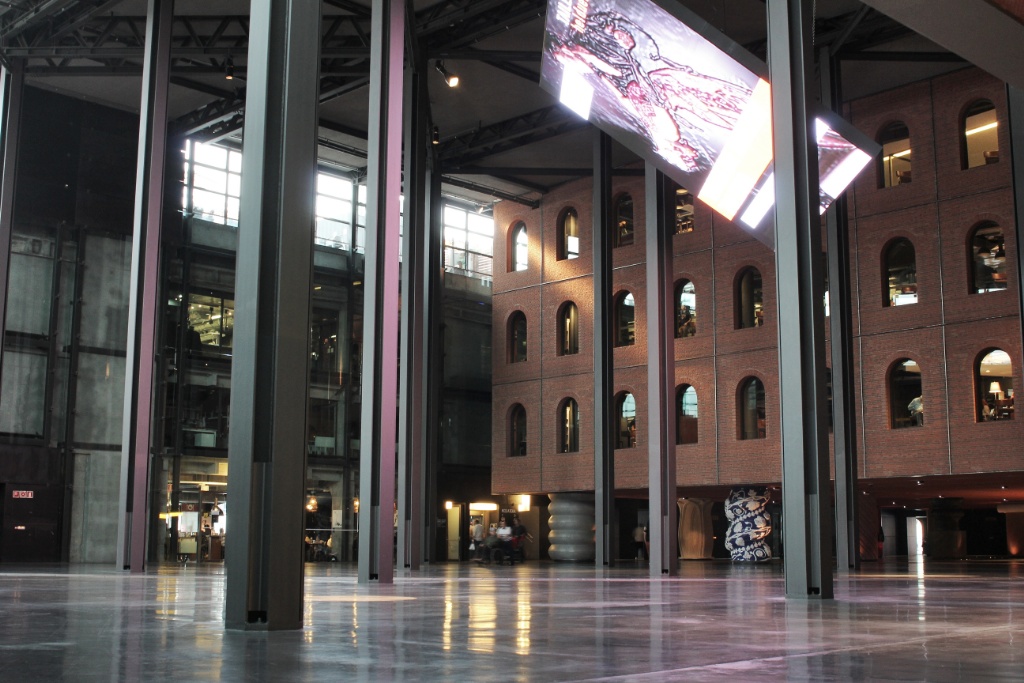
Ars Electronica’s “Artists as Catalysts” exhibition opens on July 4th in Bilbao—in the Alhóndiga Bilbao, to be precise. What’s this all about?
First of all, it’s about the fact that catalysts normally accelerate processes. For our exhibition, we selected artists who, in light of their artworks and artistic practices, function in exactly this way. Despite all the differences among them, these artists have one thing in common: They consider their work not only as a personal take on contemporary aesthetics; beyond this, they deal with social, economic or political issues, and see their artistic elaborations as contributions to addressing a particular problem. Thus, they use artistic means to expose, provoke, satirize, visualize and focus public attention on processes that are associated with the public interest and the common good. Here, the artistic ego is not a self-sufficient end unto itself; rather, it seeks an integral role as an essential part of society, often even in direct collaboration with social activists and thus as an accelerant of these processes.
Concrete examples?
The works of Finnbogi Pétursson and Cesar Harada are prime examples. Pétursson has constructed an impressive water basin installation and bombards the water with high-frequency waves that evoke questions about our relationship to our planet, while Harada’s Open-H20 group for ocean sensing and cleaning offers what amounts to a instruction manual for reducing pollution of the Earth’s oceans by means of drone sailboats. Eric Paulos, for his part, has tinkered together energy-tapping mechanical parasites that pointedly call into question how humankind deals with energy resources. Daan van den Berg hacked IKEA. The outcome: a virus-infected lamp that can be fabricated with a 3-D printer. The point: when it comes to promising, sustainable ideas, what’s called for is, above all, creative waywardness and not just high-tech developments that generate standardized mass merchandise. These are summaries of just a few of the projects dealing with the environment and a sustainable future. But here it’s also absolutely essential to point out that this show isn’t just a matter of exhibiting artists’ works; a key part of this is also to showcase the artists themselves. Thus, right at the entrance to the exhibition, visitors get an introduction to the artists they’ll presently be encountering. There’s a rundown on their career path, their thinking, interests and agenda, how they work and their everyday life. Plus, there’s info about exactly how and why the respective works, installations and artifacts came about. Then, and only then, are visitors confronted by works of art.
Seiko Mikami discussing final details with Gustavo Valera, who has made this exhibition possible
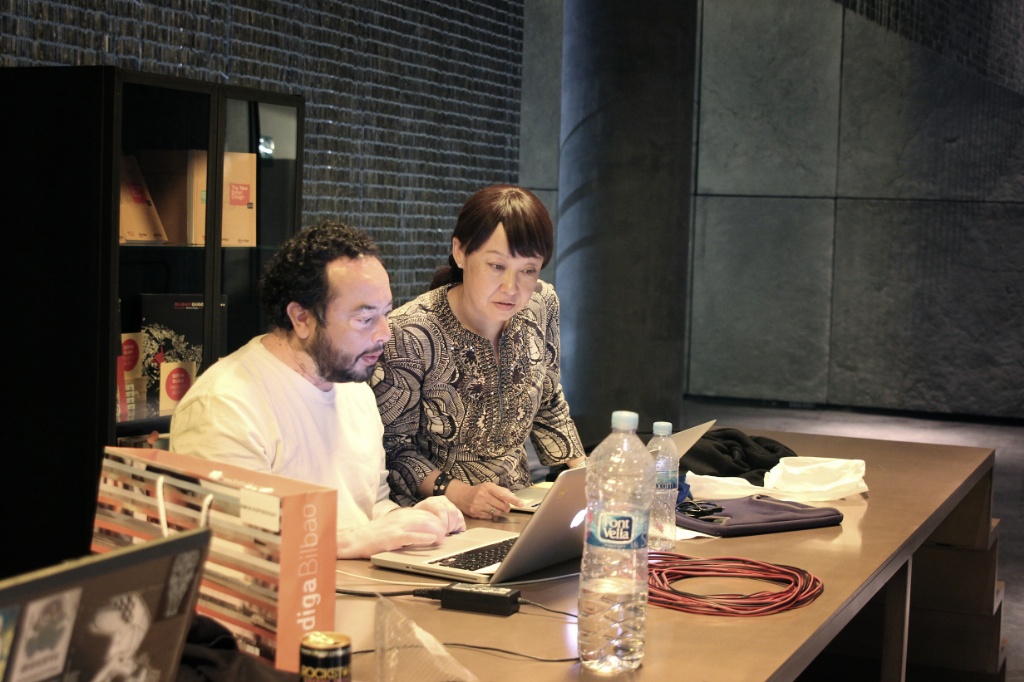
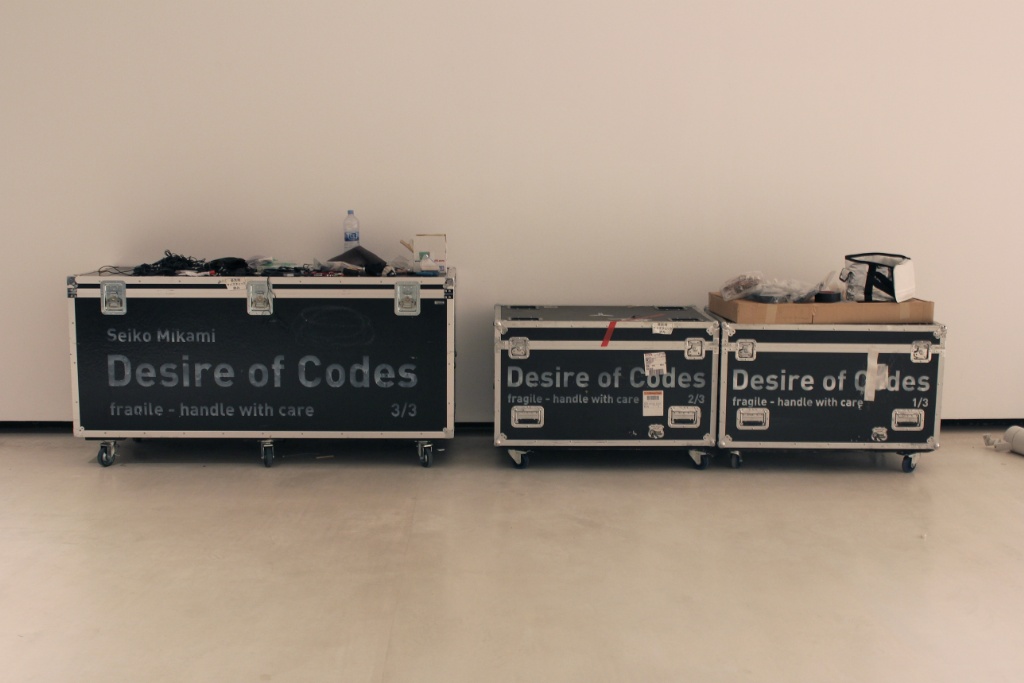
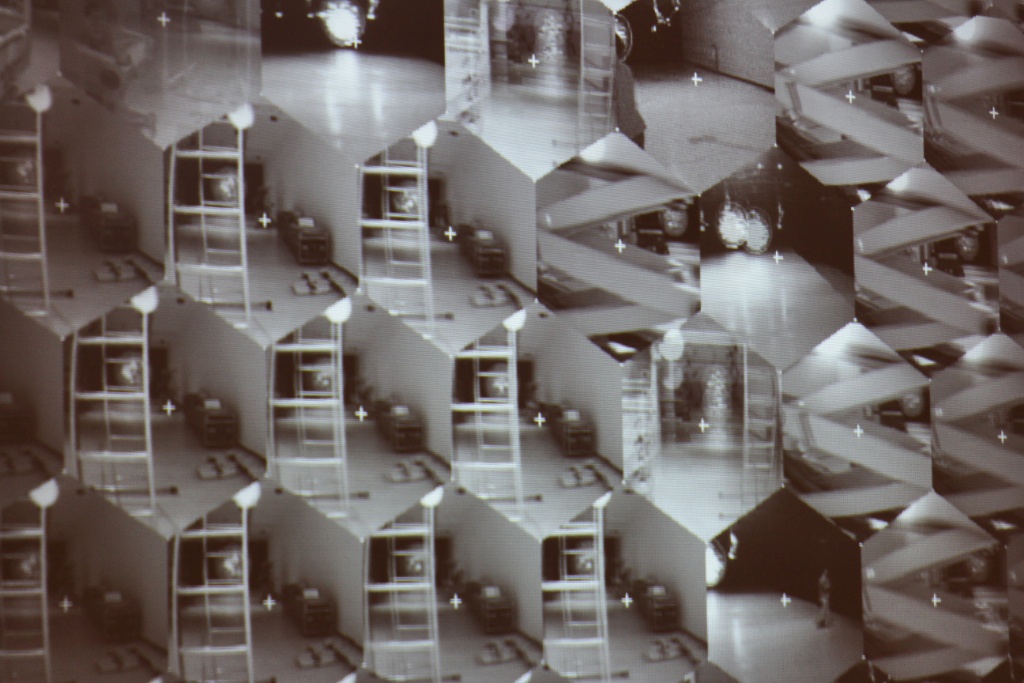
Bilbao is a name that truly resonates when it comes to art and culture. How did this collaboration between Alhóndiga Bilbao and Ars Electronica actually originate?
Ars Electronica Export very often gets the opportunity to establish a presence abroad as a result of the so-called ambassador principle, which means that our exhibitions and activities are frequently arranged by people who are members of our worldwide network. For instance, Prix Ars Electronica jurors are to thank for some of our projects in Taiwan, Sao Paulo and Spain. Some originated in acquaintanceships made at the Festival or in the Center. And an extremely important role has been played by the Ars Electronica Futurelab’s many partners and associates worldwide.
Finnbogi Pétursson takes a break next to what’s going to be “Earth”

The liaison work leading to the Bilbao exhibition was done by Gustavo Valera, an old friend of Ars Electronica with whom we’ve collaborated on a regular basis. Not only is he an absolutely brilliant technician and technical consultant to a wide range of institutions and artists; he also understands how to convey media art & culture to those partaking of it. This is clearly evident in “Hello World,” his latest project produced jointly with Ultra-Lab (http://hello-world.cc/?page_id=24). In 2012, he and Lourdes Fernández, who had just been appointed director of Alhóndiga Bilbao, came to Linz to discuss collaborative projects with the Ars Electronica Center.
So this isn’t just a one-shot deal. It’s the start of a long-term relationship. But let me put it this way: what exactly is it about Ars Electronica that interests Bilbao? And vice-versa?
We’re presently planning a biennial exhibition in Bilbao at the Alhóndiga. Plus, Lourdes Fernández and the Ars Electronica Futurelab are working on a joint artist-in-residence program. And there’ll be spinoffs—we’ve already come up with a couple of ideas. So yes indeed, the Bilbao Effect is something that gets people enthused. You walk through the streets soaking up the feeling of the architecture, and you come to the realization that design excellence is exuded by almost everything in Bilbao. And it quickly becomes clear what function a facility like Alhóndiga Bilbao has to carry out. After all, the Alhóndiga isn’t a museum complex. We’re talking about an educational & recreational facility for the people of Bilbao. In addition to the exhibition and workshop spaces on the premises, there’s a very popular mediatheque that extends over three levels, as well as a public swimming pool on the top floor—that has a glass bottom, which means you can watch the swimmers from the floor below—a gym, a cinema, an event venue, and various food & beverage establishments.
And it’s precisely this constellation or situation that Ars Electronica finds so stimulating. I’m totally sure that some very exciting things will be emerging from this partnership.
Last question: An Ars Electronica Export exhibition just opened in Berlin, and now you’re doing a guest shot in Bilbao. How long has Ars Electronica actually been producing exhibitions worldwide and in what direction is this going to develop in the future? Do you already have concrete plans?
We’ve been intensifying our activities abroad since 2004, which means that Ars Electronica Export will be celebrating its 10th anniversary next year! Over this period, we’ve made appearances in major metropolises—New York, Shanghai, Singapore, Mexico City, Sao Paulo, Venice, Tokyo and Berlin, to cite some of the biggest names—as well as smaller cities. In going about this, our mission has constantly been to strengthen Ars Electronica’s brand. Needless to say, we’re always cognizant of the fact that collaboration with artists worldwide is what’s made Ars Electronica what it is today: an institution that’s existed for 35 years, and thus probably the oldest one in the world that specializes in media art and digital culture. With our export activities, we want to continue to progress in precisely this direction. We’re ceaselessly striving to establish contact with new artists and open up presentation possibilities for them in the context of our activities. As far as future projects are concerned, I don’t want to reveal too much at this point but I can say that we’re currently intensifying our contacts with the Russian media art scene. So, maybe we’ll be able to carry out new projects in Perm, Moscow and Kaliningrad in the coming years …
“Artists As Catalysts” starts on July 4th, you can find infos about the artworks, the artists and the Alhondiga on http://export.aec.at/bilbao2013.
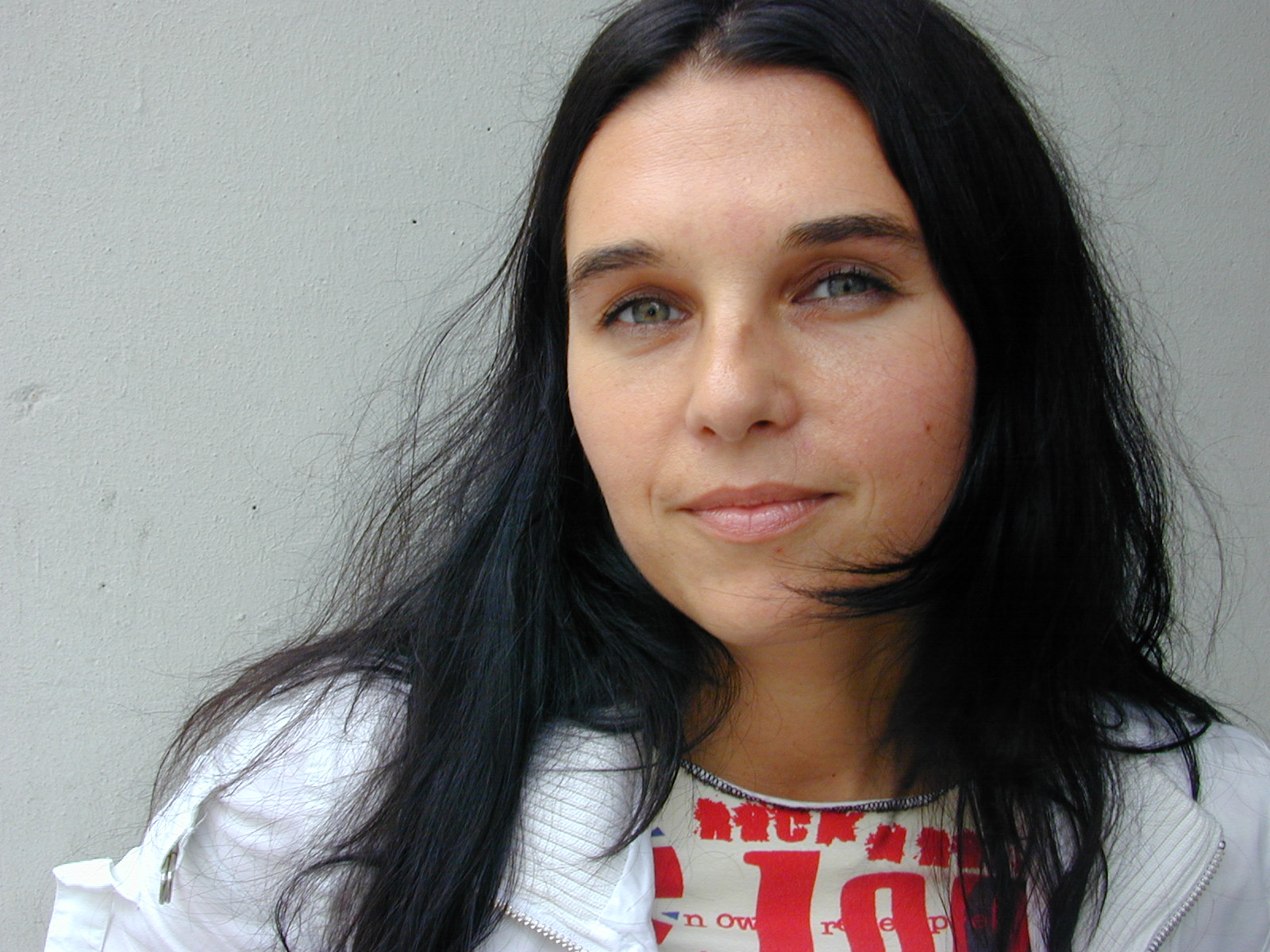
Manuela Naveau (geb. 1972), lebt und arbeitet in Linz/Österreich. Seit ihrem Studium an der Kunstuniversität Linz arbeitete sie seit 1997 als Künstlerin und Kuratorin national und international. Seit 2003 ist sie als Kuratorin und Projektmanagerin für die Ars Electronica nach Linz zurückgekehrt und gemeinsam mit Gerfried Stocker (künstlerischer Geschäftsführer der Ars Electronica Linz GmbH) entwickelte sie die Abteilung Ars Electronica Export, die sie seither operativ leitet. Neben dem Kuratieren, Produzieren und Positionieren von Ars Electronica Ausstellungen in einem internationalen Umfeld liegt ihr Interesse in den verschiedenen Erscheinungsformen zeitgenössischer künstlerischer Praxis. Zurzeit forscht Manuela Naveau zum Thema „Crowd & Art“ und untersucht in ihrer PhD Arbeit neue Formen der Partizipation an künstlerischen Prozessen über das Medium Internet sowie deren Einfluss auf eine sich im Wandel befindliche künstlerische Praxis.
